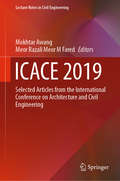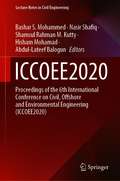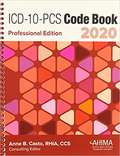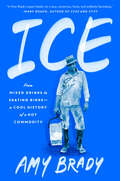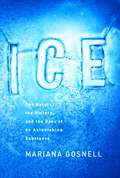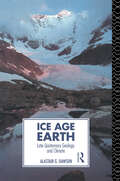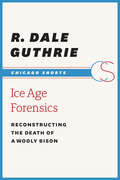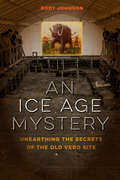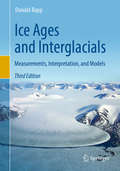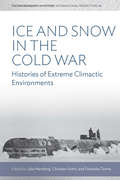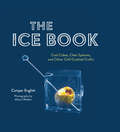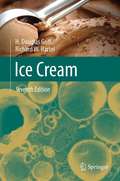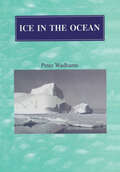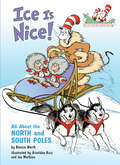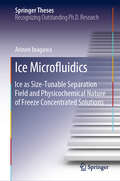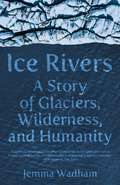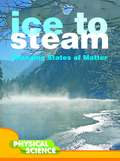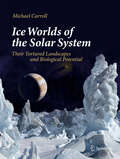- Table View
- List View
ICACE 2019: Selected Articles from the International Conference on Architecture and Civil Engineering (Lecture Notes in Civil Engineering #59)
by Mokhtar Awang Meor Razali Meor M FaredThis book presents selected articles from the 3rd International Conference on Architecture and Civil Engineering 2019, held in Kuala Lumpur, Malaysia. Written by leading researchers and industry professionals, the papers highlight recent advances and addresses current issues in the fields of civil engineering and architecture.
ICAF 2019 – Structural Integrity in the Age of Additive Manufacturing: Proceedings of the 30th Symposium of the International Committee on Aeronautical Fatigue, June 2-7, 2019, Krakow, Poland (Lecture Notes in Mechanical Engineering)
by Antoni Niepokolczycki Jerzy KomorowskiThis book gathers papers presented at the 36th conference and 30th Symposium of the International Committee on Aeronautical Fatigue and Structural integrity. Focusing on the main theme of “Structural Integrity in the Age of Additive Manufacturing”, the chapters cover different aspects concerning research, developments and challenges in this field, offering a timely reference guide to designers, regulators, manufacturer, and both researchers and professionals of the broad aerospace community.
Icarus
by Bertrand RussellMr. Haldane&’s Daedalus has set forth an attractive picture of the future as it may become through the use of scientific discoveries to promote human happiness. Much as I should like to agree with his forecast, a long experience of statesmen and governments has made me somewhat sceptical. I am compelled to fear that science will be used to promote the power of dominant groups, rather than to make men happy. Icarus, having been taught to fly by his father Daedalus, was destroyed by his rashness. I fear that the same fate may overtake the populations whom modern men of science have taught to fly.
ICCOEE2020: Proceedings of the 6th International Conference on Civil, Offshore and Environmental Engineering (ICCOEE2020) (Lecture Notes in Civil Engineering #132)
by Bashar S. Mohammed Nasir Shafiq Shamsul Rahman M. Kutty Hisham Mohamad Abdul-Lateef BalogunThis book contains papers presented in the 6th International Conference on Civil, Offshore & Environmental Engineering (ICCOEE2020) under the banner of World Engineering, Science & Technology Congress (ESTCON2020) will be held from 13th to 15th July 2021 at Borneo Convention Centre, Kuching, Sarawak, Malaysia. This proceeding contains papers presented by academics and industrial practitioners showcasing the latest advancements and findings in civil engineering areas with an emphasis on sustainability and the Industrial Revolution 4.0. The papers are categorized under the following tracks and topics of research:1. Resilient Structures and Smart Materials2. Advanced Construction and Building Information Modelling3. Smart and Sustainable Infrastructure4. Advanced Coastal and Offshore Engineering5. Green Environment and Smart Water Resource Management Systems
ICD-10-PCS Code Book, Professional Edition 2020
by Anne CastoICD-10-PCS 2020: The Complete Official Codebook contains the complete ICD-10-PCS code set and supplementary appendixes required for reporting inpatient procedures. This illustrated codebook presents the code set in 17 sections of tables arranged by general procedure type. Tables within the extensive Medical and Surgical section are additionally sectioned out by body system, indicated by color-coded page borders. ICD-10-PCS contains classifications for procedures, devices and technologies.
ICDSME 2019: Proceedings of the 1st International Conference on Dam Safety Management and Engineering (Water Resources Development and Management)
by Lariyah Mohd Sidek Gasim Hayder Ahmed Salih Mohd Hariffin BoosrohThis book presents peer-reviewed articles from the 1st International Conference on Dam Safety Management and Engineering (ICDSME 2019), organized by the Malaysian National Committee on Large Dams (MYCOLD), Tenaga Nasional Berhad (TNB), Department of Irrigation and Drainage (DID) and Universiti Tenaga Nasional (UNITEN). With the theme “resilient dams for resilient communities,” the conference highlighted the latest developments in the area and provided a platform for researchers and professionals to exchange ideas and to address dam safety and engineering issues with the environment in mind. The topics covered included, but was not limited to, best practices in dam safety, reservoir management, dam health monitoring, risk assessment, emergency management and sustainable dams.
Ice: From Mixed Drinks to Skating Rinks--a Cool History of a Hot Commodity
by Amy BradyThe unexpected and unexplored ways that ice has transformed a nation—from the foods Americans eat, to the sports they play, to the way they live today—and what its future might look like on a swiftly warming planet.Ice is everywhere: in gas stations, in restaurants, in hospitals, in our homes. Americans think nothing of dropping a few ice cubes into tall glasses of tea to ward off the heat of a hot summer day. Most refrigerators owned by Americans feature automatic ice machines. Ice on-demand has so revolutionized modern life that it&’s easy to forget that it wasn&’t always this way—and to overlook what aspects of society might just melt away as the planet warms.In Ice, journalist and historian Amy Brady shares the strange and storied two-hundred-year-old history of ice in America: from the introduction of mixed drinks &“on the rocks,&” to the nation&’s first-ever indoor ice rink, to how delicacies like ice creams and iced tea revolutionized our palates, to the ubiquitous ice machine in every motel across the US. But Ice doesn&’t end in the past. Brady also explores the surprising present-day uses of ice in sports, medicine, and sustainable energy—including cutting-edge cryotherapy breast-cancer treatments and new refrigerator technologies that may prove to be more energy efficient—underscoring how precious this commodity is, especially in an age of climate change.
Ice: The Nature, the History, and the Uses of an Astonishing Substance
by Mariana GosnellLike the adventurer who circled an iceberg to see it on all sides, Mariana Gosnell, former Newsweek reporter and author of Zero Three Bravo, a book about flying a small plane around the United States, explores ice in all its complexity, grandeur, and significance.More brittle than glass, at times stronger than steel, at other times flowing like molasses, ice covers 10 percent of the earth's land and 7 percent of its oceans. In nature it is found in myriad forms, from the delicate needle ice that crunches underfoot in a winter meadow to the massive, centuries-old ice that forms the world's glaciers. Scientists theorize that icy comets delivered to Earth the molecules needed to get life started, and ice ages have shaped much of the land as we know it.Here is the whole world of ice, from the freezing of Pleasant Lake in New Hampshire to the breakup of a Vermont river at the onset of spring, from the frozen Antarctic landscape that emperor penguins inhabit to the cold, watery route bowhead whales take between Arctic ice floes. Mariana Gosnell writes about frostbite and about the recently discovered 5,000-year-old body of a man preserved in an Alpine glacier. She discusses the work of scientists who extract cylinders of Greenland ice to study the history of the earth's climate and try to predict its future. She examines ice in plants, icebergs, icicles, and hail; sea ice and permafrost; ice on Mars and in the rings of Saturn; and several new forms of ice developed in labs. She writes of the many uses humans make of ice, including ice-skating, ice fishing, iceboating, and ice climbing; building ice roads and seeding clouds; making ice castles, ice cubes, and iced desserts. Ice is a sparkling illumination of the natural phenomenon whose ebbs and flows over time have helped form the world we live in. It is a pleasure to read, and important to read--for its natural science and revelations about ice's influence on our everyday lives, and for what it has to tell us about our environment today and in the future.From the Hardcover edition.
Ice Age Earth: Late Quaternary Geology and Climate (Physical Environment Ser.)
by Alastair G. DawsonIce Age Earth provides the first detailed review of global environmental change in the Late Quaternary. Significant geological and climatic events are analysed within a review of glacial and periglacial history. The melting history of the last ice sheets reveals that complex, dynamic and catastrophic change occurred, change which affected the circulation of the atmosphere and oceans and the stability of the Earth's crust.
Ice Age Forensics: Reconstructing the Death of a Wooly Bison
by R. Dale GuthrieFrozen mammals of the Ice Age, preserved for millennia in the tundra, have been a source of fascination and mystery since their first discovery over two centuries ago. The 1979 find of a frozen, extinct steppe bison in an Alaskan gold mine allowed paleontologist Dale Guthrie to undertake the first scientific excavation of an Ice Age mummy in North America and to test theories about these enigmatic frozen fauna. In this brilliant remaking of the death of a wooly bison over 36,000 years ago, we're given a glimpse of what life was like during the Pleistocene Epoch. From torn fragments and patches of deep-frozen skin and insights gleaned from studies of Montana bison, African lions, and Iberian cave art, Ice Age Forensics presents the story of the huge carcass Guthrie calls "Blue Babe"--and the excitement surrounding its reconstruction.
An Ice Age Mystery: Unearthing the Secrets of the Old Vero Site
by Rody L. Johnson“This lively and fascinating book is an intelligent examination of how scientific endeavor operates over time and how community life can be focused and energized. It’s also filled with portraits of colorful personalities.”—Florida Weekly "A fascinating recounting of the early discovery of a Paleolithic human and the issues that were engendered by various opposing scientific views of the validity of the discovery and its analysis."--Dennis Stanford, coauthor of Across Atlantic Ice: The Origin of America's Clovis Culture "Since the site's discovery long ago, the complete story of the Old Vero Site has never been told. This is an informative and entertaining account of this remarkable site and its history in American archaeology."--Thomas D. Dillehay, author of The Settlement of the Americas: A New Prehistory "Johnson has thoroughly investigated, and transformed into a very readable narrative, an entire century of accumulated knowledge about the research, controversy, and curiosity surrounding the Old Vero archaeological site."--Barbara A. Purdy, author of Florida's People During the Last Ice Age "An engaging account of the first Paleoindian site discovered in eastern North America."--Robert S. Carr, author of Digging Miami "Johnson skillfully weaves a tale of prehistoric life in Florida with the 100-year search to understand that long lost world at the Vero Site."--Andy Hemmings, Florida Atlantic University In 1916, to the shock of the scientific community and the world at large, a Florida geologist discovered human remains mixed with the bones of prehistoric animals in a Vero Beach canal and proclaimed that humans had lived in North America since the Ice Age. These new findings by Elias Sellards flew in the face of prevailing wisdom, which held that humans first came to the continent only 6,000 years ago. His claim was snubbed by the top scientists of his day, he was laughed out of the state, Vero's fame declined, and the skull Sellards found--famously known as "Vero Man "--was lost. An Ice Age Mystery tells the story of Sellards's exciting find and the controversy it sparked. In the years that followed, other archaeological discoveries and the rise of radiocarbon dating established that humans did arrive in North America earlier than previously thought. The skull, however, was never recovered, and many people began to wonder: What exactly had Sellards found at Vero? And what else might be buried there? One hundred years after the first Vero discovery, construction plans threatened to cover up the legendary dig site, and a band of citizens and archaeologists protested. Excavations were reopened. Archaeologists uncovered 14,000-year-old burnt mammal bones and charcoal, signs of a human presence, and found further evidence to indicate a continuous human occupation of the site for several thousand years. Prior to the latest excavations an etching on a bone possibly 13,000 years old was discovered that could be the oldest piece of art in America. Sellards had been right all along. Many questions still remain. Who were these people? Where did they come from? And how did they get here? This book draws readers into the past, present, and future of one of the most historic discoveries in American archaeology.
Ice Ages and Interglacials: Measurements, Interpretation, and Models (Springer Praxis Books. Environmental Sciences Ser.)
by Donald RappThis book provides a detailed review of terminations of ice ages, including a very attractive theory based on dust deposits on ice sheets. While other books on ice ages are mostly short, popular, and non-technical, the only book that attempts to deal with the broad issues of what we know about past ice ages and why they occur is the book by Muller and MacDonald (M&M), published by Praxis. However, despite its many good features, this book suffers from an inordinate emphasis on spectral analysis, a lack of coverage of new data, and a very confusing sequence of chapters. As a result, the data and theory are so intimately entwined that it is difficult to separate one from the other. This volume provides an independent and comprehensive summary of the latest data, theories and analysis. This third edition of what has become the premier reference and sourcebook on ice ages addresses recent topics, and includes new references, new data, and a totally new, greatly expanded treatment of terminations of ice ages.
Ice and Snow in the Cold War: Histories of Extreme Climatic Environments (Environment in History: International Perspectives #14)
by Julia Herzberg Christian Kehrt Franziska TormaThe history of the Cold War has focused overwhelmingly on statecraft and military power, an approach that has naturally placed Moscow and Washington center stage. Meanwhile, regions such as Alaska, the polar landscapes, and the cold areas of the Soviet periphery have received little attention. However, such environments were of no small importance during the Cold War: in addition to their symbolic significance, they also had direct implications for everything from military strategy to natural resource management. Through histories of these extremely cold environments, this volume makes a novel intervention in Cold War historiography, one whose global and transnational approach undermines the simple opposition of “East” and “West.”
Ice Binding Proteins: Methods and Protocols (Methods in Molecular Biology #2730)
by Ran Drori Corey A. StevensThis volume provides methods to study ice-binding proteins (IBPs), and applications involving these proteins. Chapters are divided into three parts describing identifying, isolating, and purifying ice-binding proteins, characterize both IBPs and ice-nucleating proteins (INPs), and synthesize mimics of IBPs, as well as applications involving these proteins. Written in the format of the highly successful Methods in Molecular Biology series, each chapter includes an introduction to the topic, lists necessary materials and reagents, includes tips on troubleshooting and known pitfalls, and step-by-step, readily reproducible protocols. Authoritative and cutting-edge, Ice Binding Proteins: Methods and Protocols aims to provide both experimental and simulations protocols to help new researchers, break-the-ice, and enter this exciting field, while also supporting established researchers broaden the scope of their investigations.
The Ice Book: Cool Cubes, Clear Spheres, and Other Chill Cocktail Crafts
by Camper EnglishCrystal clear spheres, cubes you can read through, embossed, branded, and blinged-out chunks, chips, blocks, and 'bergs: it's time to elevate your ice! In The Ice Book, internationally renowned cocktail icepert Camper English details how to use directional freezing to make perfectly pure ice in a home freezer, carve it up into giant diamonds and other shapes, and embed it with garnishes, including edible orchids and olives. You'll learn how to create a frozen bowl for Negroni punch, serve a Manhattan inside an ice sphere, and infuse cubes with colors and flavors to create cranberry cobblers, a color-changing Gin and Tonic, and other awesome drinks. Featuring striking color photos throughout, this handy guide—and great gift—offers easy directions for dozens of ice projects and suggestions for further freezer fun. Both instructional and inspirational, The Ice Book will help you take your nonalcoholic and boozy beverages to the next level.
Ice Climbing: The Frozen Challenge (Fountas & Pinnell LLI Gold #Level Q)
by Bob Morrow<p>Extreme Photography <p>People don't normally think of photography as an extreme sport. But many nature photographers take up extreme sports, like ice climbing, in order to capture amazing shots. <p>Imagine breathing thin mountain air, clinging to the ice with one hand and snapping a picture with the other. Photographers often take great risks to share the beauty of the mountains and ice with those on the ground. When reading this book, take a few minutes to examine the photographs. Notice the angle of each one, and imagine the story behind the photograph. What do you think the photographer needed to do to get each shot? <p>Text Elements: <p> <li>Genre: Nonfiction, Expository <li>Text Structures: Main: Categorical, Embedded: Description, Cause/Effect, Chronological Sequence <li>Text Features: table of contents, headings, photos, captions, pronunciation guides, maps, sidebars</li> </p>
Ice Cream
by H Douglas Goff Richard W HartelIce Cream, 7th Edition focuses on the science and technology of frozen dessert production and quality. It explores the entire scope of the ice cream and frozen dessert industry, from the chemical, physical, engineering and biological principles of the production process to the distribution of the finished product. It is intended for industry personnel from large to small scale processors and suppliers to the industry and for teachers and students in dairy or food science or related disciplines. While it is technical in scope, it also covers much practical knowledge useful to anyone with an interest in frozen dessert production. World-wide production and consumption data, global regulations and, as appropriate, both SI and US units are provided, so as to ensure its relevance to the global frozen dessert industry. This edition has been completely revised from the previous edition, updating technical information on ingredients and equipment and providing the latest research results. Two new chapters on ice cream structure and shelf-life have been added, and much material has been rearranged to improve its presentation. Outstanding in its breadth, depth and coherence, Ice Cream, 7th Edition continues its long tradition as the definitive and authoritative resource for ice cream and frozen dessert producers.
Ice in the Ocean
by Peter WadhamsIce in the Ocean examines sea ice and icebergs and their role in the global climate system. It is comprehensive textbook suitable for students, pure and applied researchers, and anyone interested in the polar regions, the oceans, and climate. The author examines the distribution of sea ice, its mechanisms of growth, development and decay, the thermodynamics and dynamics of sea ice, sea ice deformation and ridge-building, the role of marginal ice zones, the characteristics of icebergs, and the part played by sea ice in the climate system and in the transport of pollutants. An extensive reference list, recommendations for further reading and numerous illustrations add to the value of the text.
Ice is Nice! All About the North and South Poles: All About the North and South Poles (The Cat in the Hat's Learning Library)
by Bonnie WorthLaugh and learn with fun facts about icebergs, arctic animals, the Earth&’s axis, and more—all told in Dr. Seuss&’s beloved rhyming style and starring the Cat in the Hat! &“I&’m the Cat in the Hat, and we&’re off and away to visit the poles—North and South—in one day.&” The Cat in the Hat&’s Learning Library series combines beloved characters, engaging rhymes, and Seussian illustrations to introduce children to non-fiction topics from the real world! Bundle up for this journey to the North and South poles to learn about: how arctic animals adapt to live in the coldhow the Earth spins on its axiswhy scientists study the poles todayand much more!Perfect for story time and for the youngest readers, Ice is Nice! All About the North and South Poles also includes an index, glossary, and suggestions for further learning. Look for more books in the Cat in the Hat&’s Learning Library series!High? Low? Where Did It Go? All About Animal CamouflageIs a Camel a Mammal? All About MammalsThe 100 Hats of the Cat in the Hat: A Celebration of the 100th Day of SchoolA Great Day for Pup: All About Wild BabiesWould You Rather Be a Pollywog? All About Pond LifeHappy Pi Day to You! All About Measuring CirclesI Can Name 50 Trees Today! All About TreesFine Feathered Friends: All About BirdsMy, Oh My--A Butterfly! All About ButterfliesOh Say Can You Seed? All About Flowering PlantsInside Your Outside! All About the Human Body
Ice Mechanics for Geophysical and Civil Engineering Applications (GeoPlanet: Earth and Planetary Sciences)
by Ryszard StaroszczykIce Mechanics for Geophysical and Civil Engineering Applications
Ice Microfluidics: Ice as Size-Tunable Separation Field and Physicochemical Nature of Freeze Concentrated Solutions (Springer Theses)
by Arinori InagawaThis book explores the possibility of using micro/nanostructures formed on the doped ice surface as a novel separation platform. In addition, it provides comprehensive information on the nature of freeze-concentrated solutions (FCSs) and the ice/FCS interface, which play important roles in the natural environment and industrial processes alike. The book proposes a novel size-selective separation approach using channels formed on the doped ice surface. The separation is based on the physical interaction of analytes with channel walls, which is controlled by varying the channel width through temperature and dopant concentration changes. It also shows the precise control of the channel width to be in a range of 200 nm–4 μm and demonstrates the size-selective separation of microspheres, cells, and DNA. The physicochemical properties of FCSs are measured to reveal the nature of the ice/FCS interface, and the zeta potentials of ice are measured by determining EOF rates in a microchannel fabricated in the ice. The deprotonation at OH dangling bonds and adsorption of ions are also discussed. The viscosities of FCSs confined in micro/nanospaces are evaluated by means of two spectroscopic methods. When an FCS is confined in small spaces surrounded by ice, the viscosity increases compared to that in a bulk solution. Interestingly, this viscosity enhancement occurs even though its size is on the micrometer scale. These parameters are essential to discussing the unique phenomena occurring in FCSs. This book provides an explanation of the scientific processes taking place in FCSs, and reveals the potential that frozen solutions hold as innovative micro/nanofluidic devices and reaction platforms.
Ice Rivers: A Story of Glaciers, Wilderness, and Humanity
by Jemma WadhamA passionate eyewitness account of the mysteries and looming demise of glaciers—and what their fate means for our shared futureThe ice sheets and glaciers that cover one-tenth of Earth's land surface are in grave peril. High in the Alps, Andes, and Himalaya, once-indomitable glaciers are retreating, even dying. Meanwhile, in Antarctica, thinning glaciers may be unlocking vast quantities of methane stored for millions of years beneath the ice. In Ice Rivers, renowned glaciologist Jemma Wadham offers a searing personal account of glaciers and the rapidly unfolding crisis that they—and we—face.Taking readers on a personal journey from Europe and Asia to Antarctica and South America, Wadham introduces majestic glaciers around the globe as individuals—even friends—each with their own unique character and place in their community. She challenges their first appearance as silent, passive, and lifeless, and reveals that glaciers are, in fact, as alive as a forest or soil, teeming with microbial life and deeply connected to almost everything we know. They influence crucial systems on which people depend, from lucrative fisheries to fertile croplands, and represent some of the most sensitive and dynamic parts of our world. Their fate is inescapably entwined with our own, and unless we act to abate the greenhouse warming of our planet the potential consequences are almost unfathomable.A riveting blend of cutting-edge research and tales of encounters with polar bears and survival under the midnight sun, Ice Rivers is an unforgettable portrait of—and love letter to—our vanishing icy wildernesses.
Ice Templating and Freeze-Drying for Porous Materials and Their Applications
by Haifei ZhangFilling a gap in the literature, this is the first book to focus on the fabrication of functional porous materials by using ice templating and freeze drying. Comprehensive in its scope, the volume covers such techniques as the fabrication of porous polymers, porous ceramics, biomimic strong composites, carbon nanostructured materials, nanomedicine, porous nanostructures by freeze drying of colloidal or nanoparticle suspensions, and porous materials by combining ice templating and other techniques. In addition, applications for each type of material are also discussed. Of great benefit to those working in the freeze-drying field and researchers in porous materials, materials chemistry, engineering, and the use of such materials for various applications, both in academia and industry.
Ice to Steam (Let's Explore Science Ser.)
by Penny JohnsonDiscusses Solids, Liquids, and Gases, Changing States of Matter, Water, and the Weather and Evaporation.
Ice Worlds of the Solar System: Their Tortured Landscapes and Biological Potential
by Michael CarrollAlthough there is a chance that certain planets may be habitable for life, the moons of planets might have even more to offer. The icy moons of Jupiter, Saturn, Uranus and Neptune have taught us important lessons about new volcanic forms—cryovolcanism—and the bizarre landscapes sculpted by those erupting geysers. Glaciers, ice mountains, and vast canyons mold the faces of these worlds of ice and thunder. Yet, many ice moons and dwarf planets, including Ceres and Pluto, are in fact sea worlds, hiding deep oceans beneath their ice crusts. This book explores the frozen worlds beyond Mars, delving into the interior forces of migrating ice diapirs, seafloor volcanism and tidal friction, which help form the landscapes found above and biologically friendly environs buried below. It covers the latest research in the field and includes interviews with today’s foremost authorities, including astrobiologists Chris McKay (NASA Ames), Ralph Lorenz (Johns Hopkins Applied Physics Laboratory) and Karl Mitchell (Jet Propulsion Laboratory). Original art by the author enhances the concepts explored in the text, recreating some of the most remarkable landscapes on icy planets and moons.
